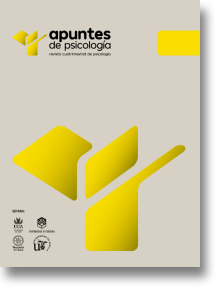Language as a collaborative process: A replication of Clark’s Collaborative Model (Schober & Clark 1989)
DOI:
https://doi.org/10.55414/p2w31r82Keywords:
Communication , Language , Psychotherapy , Collaborative model , ReplicationAbstract
The present study attempts to replicate two experimental designs conducted by Clark and his colleagues in 1989, testing the collaborative model of language. In this study, the Tangram task is replaced by a bomb defusal task using the video game Keep Talking and Nobody Explodes. A total of 20 pairs of participants were analyzed based on time taken, number of errors, number of speaking turns, and word count. Similar to the original 1987 study, in another phase of the experiment, a third person (an overhearer) performed the task by listening to a recording of another pair deactivating
bombs. The results of this study indicate a reduction in the number of interventions and words across the trials, as well as a decrease in the number of errors and time spent. No significant differences were found between the performance of pairs carrying out the task and that of non-communicating listeners. These data suggest that language does indeed tend to follow a collaborative model based on common references.
References
Anderson, T., Crowley, M.E.J., Himawan, L., Holmberg, J.K. y Uhlin, B.D. (2016). Therapist facilitative interpersonal skills and training status: A randomized clinical trial on alliance and outcome. Psychotherapy Research, 26(5), 511-529. https://doi.org/10/gd3vfb
Antaki, C. (2010). Formulations in psychotherapy. En A. Peräkylä, C. Antaki, S. Vehviläinen y I. Leudar (Eds.), Conversation analysis and psychotherapy (pp. 26-42). Cambridge University Press.
Arntz, A., Hawke, L.D., Bamelis, L., Spinhoven, P. y Molendijk, M.L. (2012). Changes in natural language use as an indicator of psychotherapeutic change in personality disorders. Behaviour Research and Therapy, 50(3), 191-202. https://doi.org/10.1016/j.brat.2011.12.007
Barr, D.J. y Keysar, B. (2002). Anchoring comprehension in linguistic precedents. Journal of Memory and Language, 46(2), 391-418. https://doi.org/10.1006/jmla.2001.2815
Bavelas, J.B. (2012). Connecting the lab to the therapy room. Microanalysis, co-construction, and solution-focused brief therapy. En C. Franklin (Ed.), Solution-focused brief therapy: A handbook of evidence-based practice. Oxford University Press.
Bavelas, J.B. (2021). Face-to-face dialogue: Theory, research, and applications. Oxford University Press.
Bavelas, J.B., Coates, L., & Johnson, T. (2002). Listener responses as a collaborative process: The role of gaze. Journal of Communication, 52(3), 566-580, https://doi.org/10.1111/j.1460-2466.2002.tb02562.x
Bavelas, J., Gerwing, J. y Healing, S. (2017). Doing mutual understanding. Calibrating with micro-sequences in face-to-face dialogue. Journal of Pragmatics, 121, 91-112. https://doi.org/10/gfxcqq
Beyebach, M. (2009). Integrative brief solution-focused therapy: A provisional roadmap. Journal of Systemic Therapies, 28(3), 18-35. https://doi.org/10.1521/jsyt.2009.28.3.18
Clark, H.H. y Wilkes-Gibbs, D. (1986). Referring as a collaborative process. Cognition, 22(1), 1-39. https://doi.org/10.1016/0010-0277(86)90010-7
Clark, H.H. y Schaefer, E.F. (1987). Collaborating on contributions to conversations. Language and Cognitive Processes, 2(1), 19-41. https://doi.org/10.1080/01690968708406350
Clark, H.H. y Schaefer, E.F. (1989). Contributing to discourse. Cognitive Science, 13(2), 259-294. https://doi.org/10.1207/s15516709cog1302_7
Clark, H.H. (1996). Using language. Cambridge University Press.
De Jong, P., Jordan, S.S., Healing, S. y Gerwing, J. (2020). Building miracles in dialogue: observing co-construction through a microanalysis of calibrating sequences. Journal of Systemic Therapies, 39(2), 84-108. https://doi.org/10.1521/jsyt.2020.39.2.84
De Shazer, S. (1985). Keys to solution in brief therapy. Norton.
De Shazer, S., Berg, I.K., Lipchik, E., Nunnally, E., Molnar, A., Gingerich, W. y Weiner-Davis, M. (1986). Brief therapy: Focused solution development. Family Process, 25(2), 207-221. https://doi.org/10.1111/j.1545-5300.1986.00207.x
Dolev, T. y Zilcha-Mano, S. (2019). The role of the therapeutic relationship in the association between interpersonal behaviors and outcome: Comparison of two competing models. Psychotherapy Research, 29(5), 553‐564. https://doi.org/10.1080/10503307.2017.1422215
Doré, B.P. y Morris, R.R. (2018). Linguistic synchrony predicts the immediate and lasting impact of text-based emotional support. Psychological Science, 29(10), 1716-1723. https://doi.org/10/gff33k
Elliott, R. (2007). Decoding insight talk: Discourse analyses of insight in ordinary language and in psychotherapy. En L.G. Castonguay y C. Hill (Eds.), Insight in psychotherapy (pp. 167-185). American Psychological Association. https://doi.org/10.1037/11532-008
Fisch, R., Weakland, J.H. y Segal, L. (1982). The tactics of change: Doing therapy briefly. Jossey-Bass.
Froján-Parga, M.X., Ruiz-Sancho, E.M., Montaño-Fidalgo, M., Calero Elvira, A. y Alpañés Freitag, M. (2011). Estudio comparativo de la conducta verbal del terapeuta según su experiencia durante la evaluación clínica. Anales de Psicología, 27(2), 311-318.
Gergen, K.J. (2006). Construir la realidad: El futuro de la psicoterapia. Paidós.
Gerwing, J., Healing, S. y Menichetti, J. (2023). Microanalysis of Clinical Interaction (MCI). En S. Bigi y M. Grazia Rossi (Eds.), A Pragmatic agenda for healthcare: Fostering inclusion and active participation through shared understanding. John Benjamins Publishing Company. https://doi.org/10.1075/pbns.338
Grant, A.M. (2012). Making positive change: A randomized study comparing solution-focused vs. problem-focused coaching questions. Journal of Systemic Therapies, 31(2), 21-35. https://doi.org/10/gftxdf
Grant, A.M. y Gerrard, B. (2020). Comparing problem-focused, solution-focused and combined problem-focused/solution-focused coaching approach: Solution-focused coaching questions mitigate the negative impact of dysfunctional attitudes. Coaching: An International Journal of Theory, Research and Practice, 13(1), 61-77. https://doi.org/10.1080/17521882.2019.1599030
Grice, P. (1975). Logic of conversation. Reimpreso en 2013 en M. Ezcurdia y R.J. Stainton (Eds.), The Semantics-Pragmatics Boundry in Philosophy (pp. 47-81). Broadview Press.
Haviland, S.E. y Clark, H.H. (1974). What’s new? Acquiring new information as a process in comprehension. Journal of Verbal Learning and Verbal Behavior, 13(5), 512-521. https://doi.org/10.1016/S0022-5371(74)80003-4
Heritage, C. y Watson, D.R. (1979). Formulations as conversational objects. En G. Psathas (Ed.), Everyday language (pp. 123-162). Irvington Press.
Jordan, S.S., Froerer, A.S. y Bavelas, J.B. (2013). Microanalysis of positive and negative content in solution-focused brief therapy and cognitive behavioral therapy expert sessions. Journal of Systemic Therapies, 32(3), 46-59. https://doi.org/10/gfxcqr
Kadur, J., Lüdemann, J. y Andreas, S. (2020). Effects of the therapist’s statements on the patient’s outcome and the therapeutic alliance: A systematic review. Clinical Psychology & Psychotherapy, 27(2), 168-178. https://doi.org/10.1002/cpp.2416
Keysar, B., Barr, D.J. y Horton, W.S. (1998). The egocentric basis of language use: Insights from a processing approach. Current Directions in Psychological Science, 7(2), 46-49. https://doi.org/10.1111/1467-8721.ep13175613
Korman, H., Bavelas, J.B. y De Jong, P. (2013). Microanalysis of formulations in solution-focused brief therapy, cognitive behavioral therapy, and motivational interviewing. Journal of Systemic Therapies, 32(3), 31-45. https://doi.org/10/gfxcp8
MacMartin, C. (2010). Resisting optimistic questions in narrative and solution-focused therapies. En A. Peräkylä, C. Antaki, S. Vehviläinen e I. Leudar (Eds.), Conversation analysis and psychotherapy (pp. 80-99). Cambridge University Press.
Muntigl, P. y Horvath, A.O. (2014). The therapeutic relationship in action: How therapists and clients co-manage relational disaffiliation. Psychotherapy Research, 24(3), 327-345. https://doi.org/10/gfxcqn
Pardo-Cebrián, R., Calero-Elvira, A., Guerrero-Escagedo, M.C. y López-Gómez, A. (2021). What works in the Socratic debate? An analysis of verbal behaviour interaction during cognitive restructuring. Behavioural and Cognitive Psychotherapy, 49(5), 513-525. https://doi.org/10.1017/S1352465820000880
Peräkylä, A. (2011). After interpretation: Third-position utterances in psychoanalysis. Research on Language & Social Interaction, 44(3), 288-316. https://doi.org/10.1080/08351813.2011.591968
Pereira, G.L., Trujillo-Sanchez, C., Alonso-Vega, J., Echevarría-Escalante, D. y Froxán-Parga, M.X. (2023). What do we know about highly effective therapists? A systematic review. Anales de Psicología, 39(1), 10-19. https://doi.org/10.6018/analesps.499371
Rude, S., Gortner, E.-M. y Pennebaker, J. (2004). Language use of depressed and depression-vulnerable college students. Cognition & Emotion, 18(8), 1121-1133. https://doi.org/10.1080/02699930441000030
Sánchez-Prada, A. y Beyebach, M. (2014). Solution-focused responses to “No Improvement”: A qualitative analysis of the deconstruction process. Journal of Systemic Therapies, 33(1), 48-61. https://doi.org/10.1521/jsyt.2014.33.1.48
Schober, M.F. y Clark, H.H. (1989). Understanding by addressees and overhearers. Cognitive Psychology, 21(2), 211-232. https://doi.org/10.1016/0010-0285(89)90008-X
Stalnaker, R. (2002). Common ground. Linguistics and Philosophy, 25, 701-721. https://doi.org/10.1023/A:1020867916902
Steel Crate Games (2015). Keep Talking and Nobody Explodes (videojuego versión para computadora).
Stiles, W.B. (2009). Responsiveness as an obstacle for psychotherapy outcome research: It’s worse than you think. Clinical Psychology: Science and Practice, 16(1), 86-91. https://doi.org/10/c3zqnq
Stiles, W.B., Caro Gabalda, I. y Ribeiro, E. (2016). Exceeding the therapeutic zone of proximal development as a clinical error. Psychotherapy, 53(3), 268-272. https://doi.org/10.1037/pst0000061
Tomori, C. y Bavelas, J.B. (2007). Using microanalysis of communication to compare solution-focused and client-centered therapies. Journal of Family Psychotherapy, 18(3), 25-43. https://doi.org/10.1300/J085v18n0
Watzlawick, P., Bavelas, J.B. y Jackson, D.D. (1967). Pragmatics of human communication: A study of interactional patterns, pathologies, and paradoxes. Norton.
Watzlawick, P., Bavelas, J.B. y Jackson, D.D. (2011). El existencialismo y la teoría de la comunicación humana: un enfoque. En P. Watzlawick, J.B. Bavelas, & D.D. Jackson, Teoría de la comunicación humana: Interacciones, patologías y paradojas (pp. 235-248). https://doi.org/10.2307/j.ctvt9k0tj.12
Zamanillo, A. y Rodríguez-Morejón, A. (2021). Language analysis in solution-focused therapy training: comparing trainees with their trainer. Journal of Solution FocusedPractices, 5(2), 39-50. https://doi.org/10.59874/001c.75045
Downloads
Published
Issue
Section
License
Copyright (c) 2024 Apuntes de Psicología

This work is licensed under a Creative Commons Attribution-NonCommercial-NoDerivatives 4.0 International License.


















